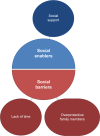Barriers and enablers of physical activity engagement for patients with COPD in primary care
- PMID: 28405162
- PMCID: PMC5378459
- DOI: 10.2147/COPD.S119806
Barriers and enablers of physical activity engagement for patients with COPD in primary care
Abstract
Background: Given that physical activity (PA) has a positive impact on COPD symptoms and prognosis, this study examined the factors that both encourage and limit participation in PA for individuals with COPD in a primary care setting from the perspective of social cognitive theory.
Methods: A purposive sample of 26 individuals with a range of COPD severity (age range: 50-89 years; males =15) were recruited from primary care to participate in one of four focus groups. Thematic analysis was undertaken to identify key concepts related to their self-efficacy beliefs.
Results: Several barriers and enablers closely related to self-efficacy beliefs and symptom severity were identified. The main barriers were health related (fatigue, mobility problems, breathing issues caused by the weather), psychological (embarrassment, fear, frustration/disappointment), attitudinal (feeling in control of their condition, PA perception, older age perception), and motivational. The main enabling factors were related to motivation (autonomous or controlled), attitudes, self-regulation, and performance accomplishments.
Clinical implications: When designing interventions for individuals with COPD, it is important to understand the patient-specific social cognitive influences on PA participation. This information can then inform individually tailored management planning.
Keywords: COPD; barriers; enablers; primary care; self-efficacy; social cognitive theory.
Conflict of interest statement
Disclosure The authors report no conflicts of interest in this work.
Figures
References
-
- American Lung Association [webpage on the Internet] [Accessed August 15, 2015];Chronic Obstructive Pulmonary Disease (COPD) Fact Sheet – American Lung Association. 2015 Available from: http://www.lung.org/lung-disease/copd/resources/facts-figures/COPD-Fact-...
-
- Hill K, Geist R, Goldstein RS, Lacasse Y. Anxiety and depression in end-stage COPD. Eur Respir J. 2008;31:667–677. - PubMed
-
- BTS BTS Guideline on Pulmonary Rehabilitation in Adults. 2015. [Accessed October 1, 2015]. Available from: http://fysio.dk/Upload/Fafo/PDF/Kliniske%20Retningslinjer/KOL/BTS-pulmon....
-
- Garcia-Aymerich J, Lange P, Benet M, Schnohr P, Antó JM. Regular physical activity modifies smoking-related lung function decline and reduces risk of chronic obstructive pulmonary disease: a population-based cohort study. Am J Respir Crit Care Med. 2007;175(5):458–463. - PubMed
-
- Dressendorfer R, Haykowsky M, Eves N. Exercise for Persons with Chronic Obstructive Pulmonary Disease. American College of Sports Medicine; 2015. [Accessed August 15, 2015]. Available from: http://www.co.monterey.ca.us/home/showdocument?id=16226.
Publication types
MeSH terms
Grants and funding
LinkOut - more resources
Full Text Sources
Other Literature Sources
Medical



